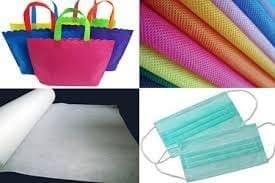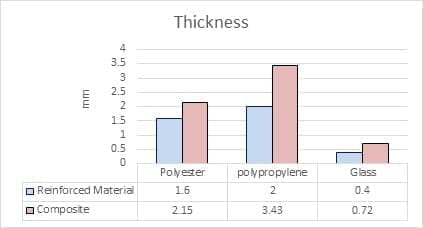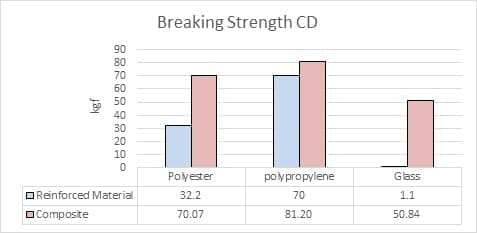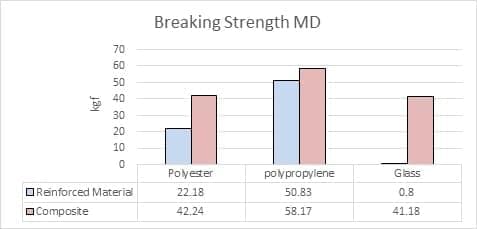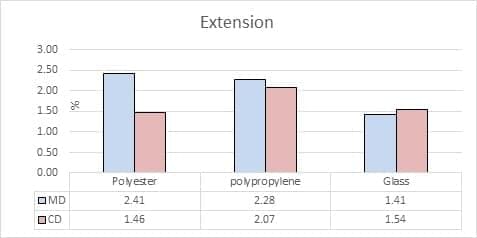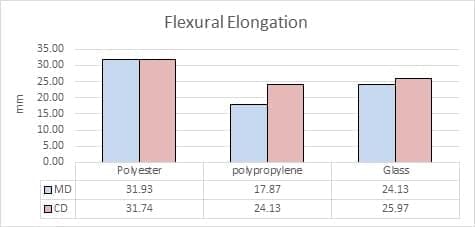Mrs. Pooja M. Katkar, Prof. (Dr.) P.V. Kadole
DKTES’s Textile & Engineering Institute, Ichalkaranji.
Abstract
Light but strong, the modern composite materials are. Composites reinforced with nonwoven structures is an unexplored, undiscovered sector. Selection of an appropriate matrix reinforced with suitable material results into a new material to meet exact requirements of a particular application. Glass fibre is most extensively used as a reinforced material in composites in different forms, viz. staple fibres, filaments, glass nonwoven web etc. Major drivers of increasing demand in various sectors are primarily the advantages, such as non-corrosive nature, light weight, good mechanical properties, easy process-ability, etc., associated with fiberglass reinforced composites, Polyester resin is most commonly used resin in fibre glass composites. Present work aims to study feasibility of needle punched nonwovens as a reinforcement in polyester resin, comparing composites reinforced with polyester needle punched nonwoven and polypropylene needle punched nonwoven with glass fibre web reinforced composites.
Key Words: Glass fibre, Nonwoven, Polyester fibre, Polypropylene fibre, Polyester resin
- Introduction
Material scientist’s define composites as a combination of two or more materials to get the desired performance from the final product [1]. The composite material result into different characteristics from the individual constituent materials which also differ significantly in physical or chemical properties. Composites are being made by human beings for many thousands of years. Mud bricks is one of the early example. To acquire good mechanical properties, mud and straw are mixed together to form a composite, excellent building blocks. Concrete is an example of ancient composite. Concrete composite is a mixture of aggregate, cement and sand. Metal rods when added into the concrete, increases its load bearing capacity of composite. Resultant rod reinforced concrete composite is called reinforced concrete.
Nonwoven fabrics are engineered fabrics, to suit for specific jobs having good balance between product use-life and cost. No doubt, these engineered materials suits the job, providing specific functions such as absorbency, water repellence, softness, cushioning, thermal insulation, acoustic insulation, filtration etc., but they cannot be used directly in the specific applications of construction, automotive etc., due to less dimensional stability and comparatively lower strength, to suit these applications. Nevertheless, nonwovens, unlike reinforcement in the form of fibres, exhibit z-directional properties, because of three dimensional structures. Owing to the contribution towards z- axis, nonwovens as a reinforcement enhances specific characteristics to composites. Thus, in making composite structures, nonwovens are popularly used for numerous applications, such as automotive parts, construction sector, packing material etc., since they enjoy a good blend of load bearing capacity, lightweight, and controllability compared to conventional composite structures [2].
- Experimental
Materials
- Following materials were used as reinforcement : –
- Polyester needle punched nonwoven : 200 GSM
- Polypropylene needle punched nonwoven : 200 GSM
- Glass fibre Web : 200 GSM
- Resins : Polyester
Methodology
Polyester needle punched nonwoven, polypropylene needle punched nonwoven and glass web were used as reinforced material and unsaturated polyester is used as matrix to develop nonwoven reinforced composites. For glass web, the direction showing higher tensile strength was treated as cross direction to enable easy comparison of type of fibre in reinforced structure.
Non-woven reinforced composites were made by hand lay-up technique. Then the composites were cured at room temperature for 90 minutes. Composite samples were tested for tensile strength, flexural strength, hardness, machinability, water absorption and moisture absorption. The results of these tests were analyzed statistically to understand effect of reinforced nonwovens, manufactured using different fibres, on properties of composites.
- Results and Discussion
Nonwoven reinforced composites were tested for various properties such as tensile strength, flexural strength, hardness, machinability, water absorption and moisture absorption.
3.1 Thickness: The distance between the top and bottom surface, thickness of composite, was measured manually using a vernier caliper.
Figure 1 Effect of Reinforced Material on Thickness
There is significant difference in the thickness of three composite samples at 5% LOS, the reason being significant difference in the thickness of reinforced material. Since glass fibre has comparatively highest density, thickness of glass web is lowest at same GSM.
3.2. Tensile Strength
The breaking strength of composite is tested on Instron 5565 with ASTM standard D3039 [3] in both machine as well as in cross direction.
3.2.1 Cross Direction
The results shows that there is significant difference in the breaking strength of composite in cross direction tested at 5% LOS.
Highest strength realization of glass web attributes to non-bonding of glass fibres in raw stage. Compared to polypropylene, polyester composite shows more strength realization which denotes better compatibility of polyester resin with polyester fibres.
When compared, composite strength with three different reinforcement, higher strength is observed in polypropylene followed by glass and then polyester, may be because of more number of fibres, thus more surface area available for interaction with resin, due to lower density of polypropylene.
Figure 2 Effect of Reinforced Material on Breaking Strength CD
3.2.2 Machine Direction
Figure 3 Effect of Reinforced Material on Breaking Strength MD
In machine direction also similar trend in results of composite strength is noted, with significant difference at 5% LOS. As compared to machine direction, cross direction shows more strength because of better fibre orientation in cross direction.
3.3 Extension
Figure 4 Effect of Reinforced Material on Extension %
Since resin arrests fibres in composites, extension in all the three composites is very less i.e. 1-2 %. There is no significant difference in the extension of polyester, polypropylene and glass composite in machine as well as in cross direction.
Since in cross direction, fiber orientation is better than machine direction, in all the three composites comparatively more extension is recorded in machine direction.
3.4 Flexural Strength
The flexural Strength is measured on Instron 5565 with ASTM standard D7264 [4] and the results are as follows:
Figure 5 Effect of Reinforced Material on Flexural Strength
At 5% LOS, significant difference in flexural strength has been observed both in machine as well as in cross direction of three types of composites. Polypropylene composite shows maximum flexural strength in both machine and cross direction. This may be because of lower density of polypropylene there are more number of fibres interacting with matrix, followed by polyester and glass. Cross direction bending strength is more because of better orientation of fibres.
3.5 Flexural Elongation
Polypropylene composite is stiffer than polyester and glass, because of comparatively more no interacting surface available for resin bonding in polypropylene composite. At 5% LOS, significant difference is found in flexural elongation of composite both in machine as well as in cross direction.
Figure 6 Effect of Reinforced Material on Flexural Elongation
3.6 Hardness
Hardness is a measure of material‘s resistance to permanent deformation or damage, a measure of plastic deformation, as is the tensile strength, traditionally, measured on an empirically scale, determined by the ability of a material to scratch another, diamond being the hardest and talc the softer [5]. The Micro hardness test procedure, ASTM E-384 [6], Vickers method, based on an optical measurement system, is used to measure hardness of composite samples, with 100 gm applied pressure, with dwell time of 20 sec.
Hardness of composite reinforced with polyester and polypropylene is higher than glass web reinforced composite. At 5 % LOS, hardness value is significantly different. This may be because of, comparatively, lower thickness of glass web reinforced composite.
3.7 Machinability
A term; ‘Machinability’ has been introduced for gradation of work materials with respect to machining characteristics. Machinability is a term indicating how the work material responds to the cutting process. Response of material towards drilling is one of the method to assess machinability of composites.
Figure 8 Effect of Reinforced Material on power requirement for drilling
A hole was drilled with a drill machine, in all the three composites. This confirms that all the three types of composites, under study, are machinable. Power required to drill the composites is significantly differing at 5 % LOS. Glass web reinforced composites require comparatively lower power for drilling because of less hardness, as discussed in previous point 3.7.
3.8 Water absorption
Water absorption, the amount of water absorbed under specified conditions, is measured with ASTM D570.
Percentage Water Absorption = [(Wet weight – Dry weight)/ Dry weight] x 100
It has been observed that there is a significant difference in the water absorption of polyester, polypropylene and glass composite at 5% LOS. This may be because of more void formation in glass composite
3.9 Moisture absorption
The moisture is known to affect a range of polymer properties, in turn performance of the product . Moisture absorption of matrix composites is a gravimetric test method based on measurement of the total mass change that is exposed to a specified environment.
The results show that there is no significant difference between the moisture absorption of the three composite samples tested at 5% LOS. Composites regain very less quantity, approximately 1%, of water, which is quite good sign of unchanged behavior of composites in actual usage.
- Conclusion
Matrix- reinforcement compatibility is the key to the manufacture of composites with good properties. Depending upon structure of fibers, they react differently towards specific resin Thus, type of fibre in nonwoven structure do affect properties of composites. Same GSM nonwoven structures, viz. polyester, polypropylene and glass web, when reinforced in polyester resin, polypropylene and polyester needle punched nonwoven reinforced composites exhibit better mechanical properties than glass web reinforced composite. Thus, we can replace glass composite by polyester or polypropylene nonwoven composites in the areas like partition board, humidification ducts, waste duct, roofing etc.

